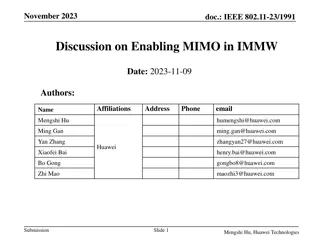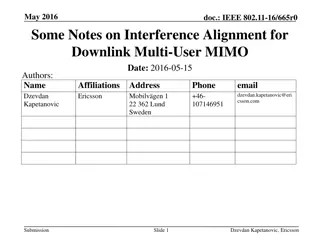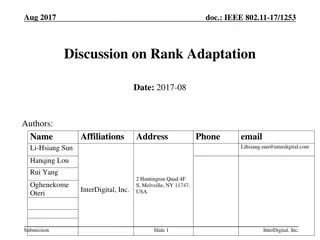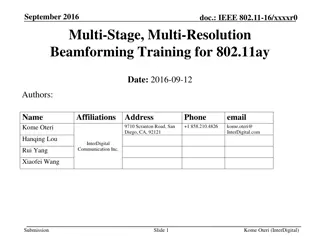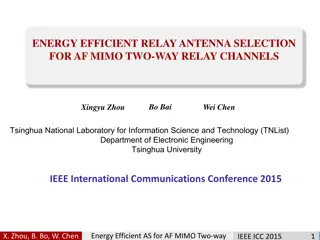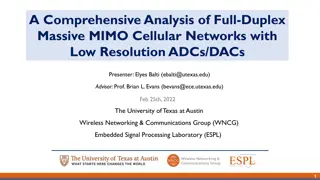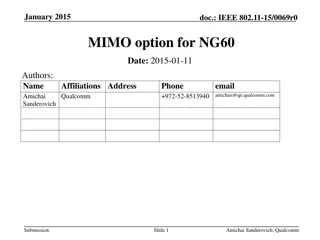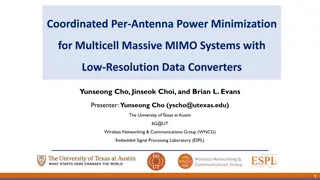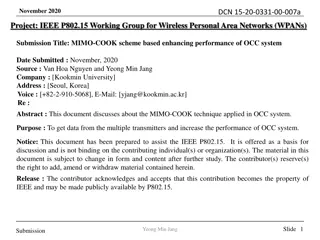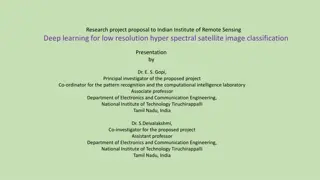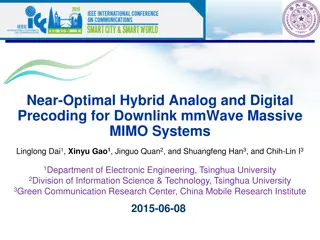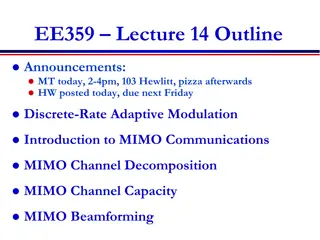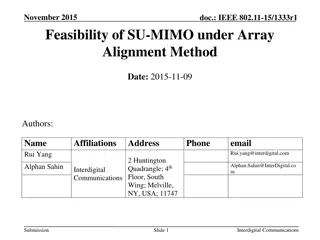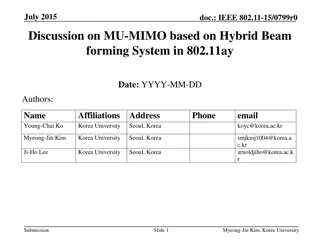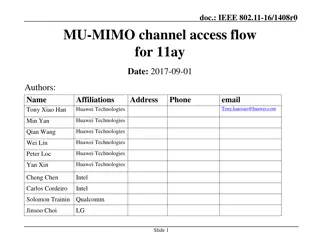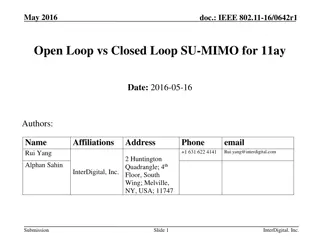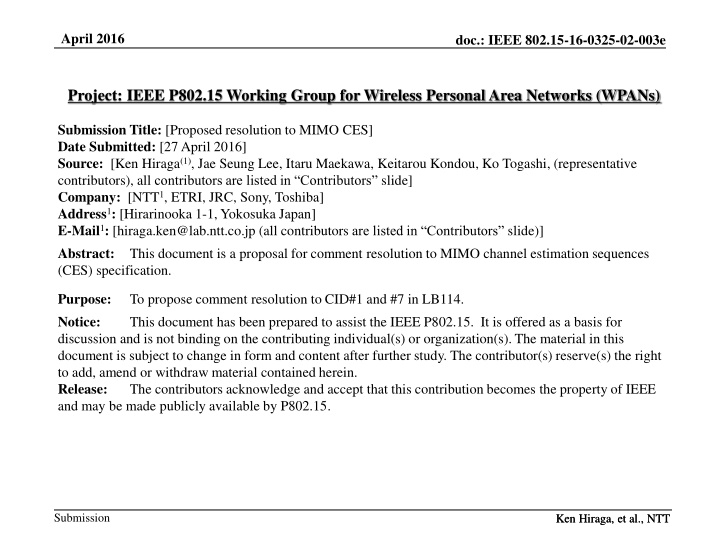
Proposed Resolution to MIMO CES Sequences
This document proposes a resolution to MIMO channel estimation sequences, addressing issues related to BPSK-modulated signals and Golay sequences in the frequency domain. The resolution offers two options for channel estimation using correlators in the time domain, aiming to enhance the MIMO CES process. It provides insights into changes needed for effective signal processing and equalization in wireless personal area networks.
Download Presentation

Please find below an Image/Link to download the presentation.
The content on the website is provided AS IS for your information and personal use only. It may not be sold, licensed, or shared on other websites without obtaining consent from the author. If you encounter any issues during the download, it is possible that the publisher has removed the file from their server.
You are allowed to download the files provided on this website for personal or commercial use, subject to the condition that they are used lawfully. All files are the property of their respective owners.
The content on the website is provided AS IS for your information and personal use only. It may not be sold, licensed, or shared on other websites without obtaining consent from the author.
E N D
Presentation Transcript
April 2016 doc.: IEEE 802.15-16-0325-02-003e Project: IEEE P802.15 Working Group for Wireless Personal Area Networks (WPANs) Submission Title: [Proposed resolution to MIMO CES] Date Submitted: [27 April 2016] Source: [Ken Hiraga(1), Jae Seung Lee, Itaru Maekawa, Keitarou Kondou, Ko Togashi, (representative contributors), all contributors are listed in Contributors slide] Company: [NTT1, ETRI, JRC, Sony, Toshiba] Address1: [Hirarinooka 1-1, Yokosuka Japan] E-Mail1: [hiraga.ken@lab.ntt.co.jp (all contributors are listed in Contributors slide)] Abstract: This document is a proposal for comment resolution to MIMO channel estimation sequences (CES) specification. Purpose: Notice: discussion and is not binding on the contributing individual(s) or organization(s). The material in this document is subject to change in form and content after further study. The contributor(s) reserve(s) the right to add, amend or withdraw material contained herein. Release: The contributors acknowledge and accept that this contribution becomes the property of IEEE and may be made publicly available by P802.15. To propose comment resolution to CID#1 and #7 in LB114. This document has been prepared to assist the IEEE P802.15. It is offered as a basis for Submission Ken Hiraga, et al., NTT Ken Hiraga, et al., NTT
April 2016 doc.: IEEE 802.15-16-0325-02-003e Contributors Name Affiliation Email Jae Seung Lee ETRI jasonlee@etri.re.kr Moon-Sik Lee ETRI moonsiklee@etri.re.kr Itaru Maekawa Japan Radio Corporation maekawa.itaru@jrc.co.jp Lee Doohwan NTT Corporation lee.doohwan@lab.ntt.co.jp Ken Hiraga NTT Corporation hiraga.ken@lab.ntt.co.jp Hideki Toshinaga NTT Corporation toshinaga.hideki@lab.ntt.co.jp Keitarou Kondou Sony Corporation Keitarou.Kondou@jp.sony.com Hiroyuki Matsumura Sony Corporation Hiroyuki.Matsumura@jp.sony.com Makoto Noda Sony Corporation MakotoB.Noda at jp.sony.com Masashi Shinagawa Sony Corporation Masashi.Shinagawa@jp.sony.com Ko Togashi Toshiba Corporation ko.togashi@toshiba.co.jp Kiyoshi Toshimitsu Toshiba Corporation kiyoshi.toshimitsu@toshiba.co.jp Submission Slide 2 Ken Hiraga, et al., NTT Ken Hiraga, et al., NTT
April 2016 doc.: IEEE 802.15-16-0325-02-003e Proposed resolution to CID #7 on MIMO CES CI D Page Sub-cl ause Line # Comment Proposed Change E/T Must Be Sa tisfied ? T Yes Resol ution Stats 7 107 11a.2. 8.5.3 11a.2. 8.5.4 1~21 BPSK-modulated Ga128 signal leads to division by zero when frequency-domain equalization (as mentioned in line 8) is a pplied at the receiver. Correct the MIMO CES sequence as needed. Change Figure 11a-13 if nec essary. Accept ed Submission Slide 3 Ken Hiraga, et al., NTT Ken Hiraga, et al., NTT
April 2016 doc.: IEEE 802.15-16-0325-02-003e Introduction Resolution to CID#7: Golay a256 in the frequency domain -> IFT -> time domain waveform -> CSD. As another option for MIMO CES, we here propose one for channel estimation using correlator in time domain. Proposed resolution is to prepare two types of MIMO CES Option 1: Golay sequences a256 in the frequency domain New 11a.2.8.5.3 Option 2: Golay sequences in the time domain New 11a.2.8.5.4 Submission Ken Hiraga, et al., NTT
April 2016 doc.: IEEE 802.15-16-0325-02-003e Option #1 MIMO CES for frequency domain channel estimation Pi/2-BPSK modulated signal Frequency domain a256 = [a128 b128] IFFT Time domain waveform IFT[ a256] Cyclic shifts of 16*(i-1) [symbols] for #i th stream (i=1,2,3,...,16) Time domain waveform IFT[ a256] with cyclic shift 5 times repetitions SFD Proposed preamble structure for MIMO stream#i SYNC CES 1280 a128 a128 a128 a128 Submission Ken Hiraga, et al., NTT
April 2016 doc.: IEEE 802.15-16-0325-02-003e Option #2 MIMO CES for time domain channel estimation using correlator SFD SYNC CES SISO CES in draft 1.0 a128 a128 a128 a128 b128 a128b128a128 b128a128b128 a128b128 a128b128 a512 b512 c1024 Cyclic shifts of 16*(i-1) [symbols] for #i th stream (i=1,2,3,...,16) c1024: c1024_i: d_i_256: e_i_256: a512b512 cyclic shifted c1024 First 256 digits of c1024_i Last 256 digits of c1024_i c1024_i Append d_i_256, and prepend e_i_256 c1024_i e_i_256 d_i_256 SFD Proposed preamble structure for MIMO stream#i SYNC CES c1024_i e_i_256 d_i_256 a128 a128 a128 a128 This CES has 256-symbol ZCC zone Divide 16 streams with cyclic shift. Submission Ken Hiraga, et al., NTT
April 2016 doc.: IEEE 802.15-16-0325-02-003e To indicate MIMO CES Type... Also, in order to indicate MIMO CES type (option #1 or #2), we propose to add 1 bit , the MIMO CES Type, for MIMO IE in the beacon frame. Submission Ken Hiraga, et al., NTT
April 2016 doc.: IEEE 802.15-16-0325-02-003e Proposed change in 11a.2.8.5 MIMO PHY Preamble This is editorial fix, resolution to CID#1. The highlighted sentence does not correctly describe the CES formation shown in Figure 11a-13 and in 11a.2.8.5.3 and 11a.3.8.5.4. Change the text in 11a.2.8.5 as follows. 11a.2.8.5 MIMO PHY Preamble The Preamble is comprised of the SYNC, SFD and CES as shown in Figure 11a-13. After SFD transmission each antenna sends CES by turns. In other words, when one antenna transmits the CES, other antennas transmit unmodulated RF signals. As the figure shows, total time for CES transmission is in proportion to M. MIMO PHY assumed the implementation using frequency domain equalization (FDE). When M = 16, CES of Tx#9 ~Tx#16 are transmitted after the CES of Tx#1~Tx#8. MIMO CES should be one shown in 11a.2.8.5.3 or one shown in 11a.2.8.5.4. The type of MIMO CES is advertised by the beacon, as shown in 6.4.37. Replace Figure 11a-13 with the following figure Tx#i(i = 1 ~ 16) SFD# i CES# i Header # i Payload #i SYNC# i Figure 11a-13 PHY frame structure in MIMO mode Submission Slide 8 Ken Hiraga, et al., NTT Ken Hiraga, et al., NTT
April 2016 doc.: IEEE 802.15-16-0325-02-003e Proposed change in 11a.2.8.5.3 Replace 11a.2.8.5.3 with this. 11a.2.8.5.3 CES for frequency domain channel estimation The CES for frequency domain channel estimation is generated usingGolay complementary sequences of length 256, a256 ,which is defined in 11a.2.3.1.3. First the sequence is /2-shift-BPSK-modulated signal in the frequency domain. Then the signal is converted into time domain waveform. For each spatial stream, cyclic shift delays are applied in time domain. The value of cyclic shift delay for ith transmitter TCSces_i is TCSces_i = 128* ( i 1 ) [chips] when M = 2 TCSces_i = 64* ( i 1 ) [chips] when M = 4 TCSces_i = 28* ( i 1 ) [chips] when M = 9 TCSces_i = 16* (i 1 ) [chips] when M = 16. Finally 5 times repetition is applied to each stream. Submission Slide 9 Ken Hiraga, et al., NTT
April 2016 doc.: IEEE 802.15-16-0325-02-003e Proposed change in 11a.2.8.5.4 Replace 11a.2.8.5.4 with this. 11a.2.8.5.4 CES for time domain channel estimation CES for ith stream, which transmitted from ith transmitter is [e_i_256 c1024_i d_i_256], where c1024_i: shifted c1024 c1024: [a512b512] d_i_256: First 256 digits of c1024_i e_i_256: Last 256 digits of c1024_i Here a512 and b512 is defined in 11a.2.3.1.3. The sequence c1024_i is cyclic-shifted c1024. The value of the cyclic shift delay for ith transmitter TCSces_i is shown in 11a.2.8.5.3. Submission Slide 10 Ken Hiraga, et al., NTT
April 2016 doc.: IEEE 802.15-16-0325-02-003e Proposed change in 6.4.37 MIMO Information IE Modify Figure 6-126b as follows. Bits: b0-b3 b4-b7 b8-b12 b13-b1415 b15 SC Supported MIMO Number of MIMO Array Training Array Training Interval MIMO CES Type Number of MIMO Array Training Figure 6-126b MIMO Parameter field format Modify Figure Table 6-21a as follows. Table 6-21a Array Training Interval field values b13-b1415 000 001 010 011 100-111 Array Training Interval Time 10 ms 20 ms 40 ms 80 ms Reserved Insert following sentence after Table 6-21a. The MIMO CES Type field shall be set to 1 when MIMO CES for frequency domain channel estimation is used as described in 11a.2.8.5.3, and shall be set to 0 when MIMO CES for time domain channel estimation is used as described in 11a.2.8.5.4. Submission Ken Hiraga, et al., NTT



